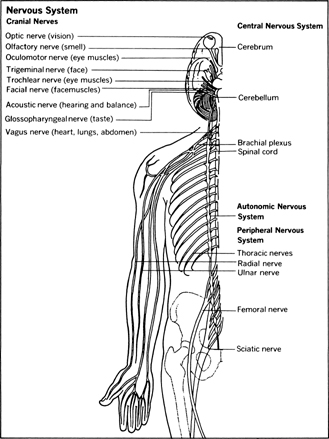The Nervous System and the Brain - The body's nervous systems
Simply speaking, the human body has only one nervous system, and that is all the nerve cells, nerve cords, nerve centers (both voluntary and involuntary) in the body. It is helpful, however, though quite arbitrary, to divide our nerves into the central and autonomic nervous systems. This division tends to obscure the countless interconnections and interplay between the two systems. For example, where do you place the control of breathing or blinking? Such actions are automatic except when we choose to regulate them.
The Central Nervous System
The central nervous system, as noted above, includes the brain and the spinal cord. It also includes all the nerves of conscious response and voluntary action that link up with the brain and spinal cord.
Twelve pairs of cranial nerves originate within the brain and emerge at its base. These include the very important nerves that connect with our sense organs, nerve bundles that control the facial and neck muscles, and the vagus (or tenth cranial nerve) that serves the heart, lungs, stomach, intestines, esophagus, larynx, liver, kidneys, spleen, and pancreas. The vagus nerve, although anatomically part of the central nervous system, controls bodily functions that are mainly automatic.
Spinal nerves branch out from the spinal cord as it snakes its way through the vertebrae of the spinal column. All the major nerve cords that wrap around the trunk and reach the arms and hands, legs and feet, originate from spinal nerves.
The cranial nerves and the spinal nerves, together with all those nerves lying outside the confines of the brain and spinal cord, are sometimes referred to as the peripheral nervous system . This term can be confusing, however, because it is also used to include all the nerves of the autonomic nervous system, next discussed.
The Autonomic Nervous System
The muscles served by the central nervous system are all of one general type (striated), while the muscles served by the autonomic system are called involuntary or smooth. The autonomic nerves regulate body activity without our conscious control—for example, as we sleep. They are rather elegantly divided into two categories: sympathetic and parasympathetic nervous systems. These are distinguishable primarily by their opposite effects on the body organs. For example, impulses along parasympathetic nerve trunks dilate blood vessels, slow the heartbeat rate, and increase stomach secretions, while the sympathetic system constricts blood vessels, increases rate of heartbeat, and inhibits stomach secretions.


Comment about this article, ask questions, or add new information about this topic: